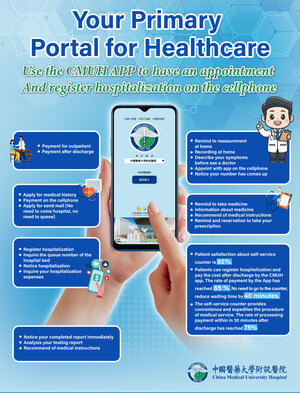China Medical University Hospital's New Tech "AI-aided Diagnostic System" Assist to Diagnose Freezing of Gait (Parkinson's Disease) in Just 30 Minutes
TAICHUNG, March 21, 2024 /PRNewswire/ -- For patients with Parkinson's Disease (PD) and gait problems, diagnosis can be challenging. Early stages of PD gait disorders require detailed neurological examinations and tests for accurate diagnosis. As for the symptoms of bradykinesia, freezing gait, and other motor dysfunctions in the mid to late stages of Parkinson's disease, they are even harder to identify with the naked eye. China Medical University Hospital (CMUH) AI Center and the Department of Neurology have utilized AI auxiliary tools to analyze the patient's gait videos and walkway pressure data utilizing the AI algorithms, to construct an "AI-aided diagnostic system for freezing of gait." With the help of AI analysis reports, the diagnostic efficiency of the physicians can be significantly improved and PD can be quickly diagnosed for early medical intervention with surgery or drug treatment.
Director Chon-Haw Tsai, Department of Neurology at CMUH, pointed out that PD is a chronic neurodegenerative disease mainly seen in elderly people aged between 60 and 80 years old. The primary cause of PD is the degeneration of the "substantia nigra" of the brain, which leads to the deficiency of the neurotransmitter dopamine in the brain. It causes disorganized and uncontrollable neural activity, which in turn leads to slowness and paucity of movement. Noticeable symptoms of the early onset include limb tremors, slowness of movement, muscle and joint stiffness, hunched back, scoliosis, etc. As indicated by international literature, the prevalence rate of people aged over 60 years old is 1%, while the prevalence rate of people aged over 80 years old is 2%. However, enormous amounts of time are often spent by physicians on the diagnosis of PD, and the time for precise therapeutic drug dose adjustment is also missed. CMUH's new technology has a great impact on the gait and balance of PD patients, which in turn influences their quality of life and independence of living alone.
71-year-old Mr. Chuang has been afflicted with PD for 15 years. In addition to walking at a slower pace, he often freezes while walking. The timing of PD's freezing of gait can often not be easily predicted. It can happen all of a sudden when the patient proceeds to the gait laboratory. With CMUH AI auxiliary tools, Mr. Chuang's crucial images were instantly captured for diagnosis, and in just 30 minutes, it turned out that Mr. Chuang had very likely suffered from the "Freezing of Gait" in the middle and late stages of PD.
The "AI-aided diagnostic system for freezing of gait" is integrated with Microsoft HoloLens 2 (mixed reality head-mounted display), facilitating instant recording of a patient's continuous gait video and immediate computer synchronization for deep learning training and interpretation. This has saved the time used to set up the video recorder and provided the clinicians with the time-segmented data automatically generated by AI.
Dr. Tsai further analyzed that having a good hold of the process of patients' PD and administering appropriate medication is often key to delaying the disease. This discovery has allowed early intervention and treatment of the patient by the CMUH medical team to delay the development of the related symptoms. Now, Mr. Chuang's gait has much improved under the control of appropriate medicines, and he is able to continue taking care of himself in daily life.
Amid the rise of telemedicine due to the COVID-19 pandemic, the "AI-aided diagnostic system for freezing of gait" offers significant benefits, including time savings, support for telemedicine, and ease of image uploading. Patients can now record and upload videos from home, enabling quick diagnosis and remote management of their condition. This system is particularly beneficial for patients in rural areas, reducing the need for hospital visits:
- Time-saving: instantly assist in the diagnosis within 30 minutes of completion of the freezing of gait examination.
- Telemedicine-friendly: patients can self-film and upload videos at home without needing to go to the hospital.
- Requires only simple equipment: the required resolution of the input video is 720p, there is no need for advanced cameras or other auxiliary equipment.
The clinical research of the PD treatment team of CMUH making use of AI medical assistance for real-time diagnosis to allow early intervention and treatment, and to delay the disease. It has been highly valued by the medical community.
Media Contact:
Carolyn Chen
+886939532029
[email protected]
SOURCE China Medical University Hospital

WANT YOUR COMPANY'S NEWS FEATURED ON PRNEWSWIRE.COM?
Newsrooms &
Influencers
Digital Media
Outlets
Journalists
Opted In






Share this article